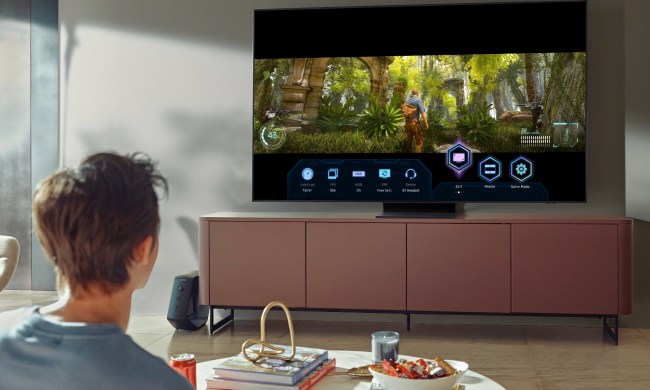
If you’ve shopped for a new TV, monitor, laptop, or game console over the last decade or so, you’ve probably seen the phrase “4K UHD” on most web pages, ads, and product boxes you’ve come across. Quite simply, this refers to a specific screen resolution — 3840 x 2160 — which is four times (hence the “4”) the amount of pixels you’d find on a non-4K display.
At this point in time, 4K displays have been mainstream for quite a while, to the point that most new televisions use 4K panels instead of 1080p (or 720p) ones. But this is merely scratching the surface. There’s a lot more to a 4K TV than just a boatload of pixels though, so let’s strap on the scuba gear and dive a little deeper, shall we? We may even learn a thing or two about 8K TVs as we swim toward the bottom.
What is 4K Ultra HD?
4K Ultra HD is the name assigned to a screen with a resolution that’s four times that of a Full HD (1080p) TV. That translates to 8 million pixels being crammed into the same space in which a Full HD TV fits just 2 million — achieved by making each pixel four times smaller. The result for the average viewer? A clearer image, more accurate color, and with most new TV sets, High Dynamic Range, or HDR (more on that in a bit).
Since each pixel is smaller, and thus each one is assigned a small slice of a bigger picture, it doesn’t make a whole lot of sense to beef up the resolution on smaller screens — the extra pixels have a bigger impact on a large screen because you can fit more of them in. As such, you’ll be hard-pressed to find too many 4K TVs with a screen smaller than 40 inches.
Is there a difference between 4K and UHD?
At the consumer level, no. The two terms are practically interchangeable. But talk to professionals in the video production or cinema industry and they’ll chew your ear off about how what we lowly consumers call 4K isn’t actually 4K at all. Technically, they’re right.
In the professional world, 4K is a digital cinema standard that calls for a 4096 x 2160-pixel resolution. That first number is a horizontal measurement, the latter vertical, and they work out because they fit a 1.85:1 aspect ratio. Looking at those numbers, it makes sense to use the term 4K, because the horizontal measurement is in the 4,000 neighborhood and is double the prior 2K (2048 x 1080) standard.

Still with us? Good, because now we’re going to come back to consumer television land, where the vast majority of us live. Here, we watch televisions with a 16:9 or 1.78:1 aspect ratio. That’s not quite as wide as what the pros use, so the pixel resolution we get ends up being 3840 x 2160 — double both the horizontal and vertical measurements of Full HD (1920 x 1080). Do that math and that’s four times the pixel resolution.
In 2013, the Consumer Electronics Association — now referred to as the Consumer Technology Association (CTA) — decided that, to end confusion and make marketing easier, Ultra HD should be the official name for the new resolution standard. Unfortunately, people have been calling it 4K for so long that the name didn’t really stick, thus manufacturers turned to branding these TVs as 4K Ultra HD, or just 4K.
Do I need a 4K Ultra HD TV?
One might as well ask: Do I need a Porterhouse steak? No, of course not! You can do just fine with a sirloin, can’t you? Likewise, your 1080p HD TV will still work years from now because 1080p digital broadcast standards aren’t going to disappear the way analog broadcasts did back in 2009.
In short: If you’re happy with your TV, there is no need to upgrade, but if you’re shopping for a new television, you’d be foolish not to take the leap to 4K Ultra HD. It’s not like the price will be standing in your way, either. There is a myriad of budget 4K TVs on the market, with pricing starting at around $300 for a 50-inch model, $400 for a 55-inch, and $500-600 for a mammoth 65-inch. Not bad, right?
It is also worth noting, though, that there are some hidden costs of buying a 4K TV, in that many streaming services will up-charge for their 4K services. It still doesn’t negate the benefits of 4K TVs, but take this into account.
What brands make the best 4K Ultra HD TVs?
There’s no shortage of 4K TVs on the market, with just about every manufacturer churning them out. That’s not to say they’re all worth your hard-earned cash, though. If you have a considerable budget, you’re best off sticking to higher-end models from bigger TV brands like LG, Samsung, and Sony, while those with less dough to burn hoping to get the largest screen for the lowest possible price ought to turn their attention to TCL or Hisense, brands that are producing stunning 4K panels that are starting to rival the big players.
In terms of which is the best TV brand, that’s relative to your price point and what you’re hoping to get out of the television. If it’s a simple interface you’re after, with oodles of streaming features baked in, you can’t go wrong with a TCL Google TV 4K model. For the best possible visuals, you’re going to want to go with an LG, Samsung, or Sony — more specifically a QLED or an OLED.

Do all 4K Ultra HD TV’s have HDR?
High dynamic range (HDR) in TVs includes multiple formats that provide brighter whites and darker blacks, making for increased color volume and shading and better contrast than standard displays, ultimately resulting in more vivid detail. Many people (including us) say that when it’s done right, HDR is a more noticeable upgrade than 4K resolution, and if you’re looking for a new reason to buy a TV, this is a great one.
Nowadays, it’s rare to find a 4K TV that doesn’t have HDR on board — though it’s still worth checking to make sure the one you’re looking at does, especially if you’re aiming at the lower end of the market. With that in mind, there are a few different varieties of HDR, including Dolby Vision, Hybrid Log-Gamma (HLG), HDR10, and its more dynamic counterpart, HDR10+. HDR10 is the most common variety, while Dolby Vision and HDR10+ will usually be found on more premium models, with some brands choosing one over the other. HLG may be important someday, but in the U.S., it’s less of a factor at present.
Can 4K Ultra HD TVs play Full HD (1080p) content?
Yes, 4K Ultra HD TVs can play Full HD content, but it won’t be displayed in the standard 1920 x 1080 resolution we’ve all come to know and love. Instead, to fill the extra pixels that make up a 4K Ultra HD screen, the content first has to be upscaled. The same applies to content shot or rendered in SD resolution.
To be clear, that doesn’t mean you have to wait for HD shows to morph into a higher resolution before you can start watching. The upscaling takes place in real time as the material is playing. Take note, however, that while most of the big-name manufacturers’ 4K Ultra HD TVs do a solid job with upscaling, some budget brands do not, so we’d suggest sticking to the aforementioned brands for the best results.
That said, if you’ve already pulled the trigger on a 4K TV with less-than-perfect upscaling, you have some options: You can either outsource it to a mid-to-high-end AV receiver with built-in 4K upscaling or if you’re playing a DVD, you can invest in a 4K Ultra HD Blu-ray player (or even an Ultra HD Blu-ray compatible Playstation 5 or Xbox Series X) as most of them have an upscaling processor of their own under the hood.

Where can I watch 4K Ultra HD content?
First and foremost, most on-demand streaming apps will host a trove of 4K films and shows. If you’re a Netflix, Prime Video, or Disney+ subscriber, you’ll be able to access 4K streams with any web-connected TV or streaming device. Do keep in mind though that 4K content is often locked behind taller paywalls than regular HD movies and shows. For example, an HD streaming plan for Netflix is $15.50 per month, while the Ultra HD subscription is now $23 per month.
If you’re more of a physical media type of person (and enjoy the added performance quality they offer), Ultra HD Blu-ray is still an excellent choice. And while Netflix’s DVD service has been gone for a minute, some good options have emerged to replace it, including Scarecrow and a few others. Of course, you can still buy DVDs on Amazon and get content from download services that offer 4K resolution content, including iTunes, Google Play, and others.
When it comes to live TV, you aren’t going to find 4K packages from many cable or satellite companies just yet, but companies like DirecTV and Comcast have started dabbling with 4K content, but it’s still very limited and mostly relegated to prerecorded or streamed media. Additionally, live TV streaming services like YouTube TV and Fubo both offer select content, mainly live sports, broadcast in 4K.
As for over-the-air broadcast television, now that ATSC 3.0 is up and running (and getting support from many new TVs), we’ll be able to start enjoying 4K HDR broadcasts, without having to pay for some kind of streaming or downloads. At this time, you won’t find too many channels broadcasting in 4K, but ATSC 3.0 is experiencing a slow rollout. For now though, you can use this tool to see which stations near you are working with ATSC 3.0 tech.
What about 4K gaming?

Game consoles like the PlayStation 5 and Xbox Series X are also capable of outputting a 4K signal to your TV. This means that as long as the game you’re playing was engineered to run in Ultra HD, you’ll be able to enjoy some of the best visuals the gaming world has to offer. Not to mention that the PS5 and Series X also double as Ultra HD Blu-ray players!
While many folks still prefer physical media, you’ll also be able to stream a lot of games in 4K too. Both the PlayStation Network and Xbox’s Game Pass platform host a number of titles in Ultra HD; and remember that even if you’re playing a slightly older game that maxes out at 1080p, newer 4K TVs will still upscale the picture, on top of enhancing your overall gameplay with features like VRR (Variable Refresh Rate) and ALLM (Automatic Low Latency Mode).
Should I buy a 4K TV or wait for 8K?
While 4K is certainly the dominant TV resolution for this day and age, 8K TVs have been around for a few years, too. With a resolution of 7680 x 4320 (or 4320p), 8K is four times that of 4K Ultra HD and 16 times that of Full HD. That may seem all too appealing, but there are a couple of reasons you’re going to want to steer clear of them for the time being — with the first being that 8K TVs are incredibly expensive.
Even if your pockets are deep, we still advise against bagging one right now. 4K Ultra HD has become the industry standard, and there’s a lot of work to be done before 8K replaces it — even if it seems like development has come in leaps and bounds. TV technology is likely to mature greatly between now and then, which could ultimately render current models obsolete.
To make matters worse, the industry is already beginning to talk about 16K, which you shouldn’t even be considering if you’re not a member of the 1%. Even then, there’s no real 16K content right now, save for some pseudoscience that allows manufacturers like Sony to show off its fidelity as best it can. The same rings true for 8K, so you’d only be bleeding your wallet for the privilege of technological clout.
Your best bet is to pour your budget into a great QLED or OLED, or perhaps a QD-OLED or mini-LED set. It will serve you better in the long run and you won’t run the risk of owning an 8K TV that could become antiquated before 8K even hits the mainstream. Right now, 4K Ultra HD is the only resolution worthy of your investment, and that won’t be changing any time soon.



